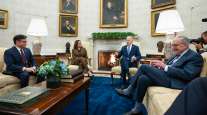‘Smart City’ Columbus Cites Technology, Collaboration as Keys to Future

Few things annoy futurist David Staley as much as when he is in his car stopped at a traffic light and no one is moving.
Not in his lane, the lanes next to him, the lanes opposite him or the lanes of cross-traffic. Everyone is stuck, waiting for their light to turn green — while the lane that has the green light is devoid of cars.
But imagine if those traffic lights knew how to react to traffic on their own, much the way a police officer directs traffic while standing in the intersection or manually manipulating the traffic light.
Or think of a day when a traffic light might not even be needed at an intersection because autonomous vehicles have a way of communicating with each other so that they don’t collide or hit someone walking across the street.

Getty Images
RELATED: How the US DOT harnesses mobility data to make more intelligent transportation systems
“Sensors and other technology can make traffic lights smarter and able to sense traffic,” said Staley, an associate professor of history, design and educational studies at Ohio State University.
Giving Columbus these kind of smarts is a key goal for the city, which beat out 77 other cities in the Smart City competition in 2016. Winning included a $40 million grant from the U.S. Department of Transportation for research on what a smart-transportation system could look like, and a $10 million grant from Paul G. Allen Philanthropies meant to reduce greenhouse gas emissions, mostly by encouraging more consumer and fleet adoption of electric vehicles.
Smart Columbus, a collaboration of the city and the Columbus Partnership, which is composed of local civic and business leaders, has used those grant dollars to leverage commitments totaling more than $500 million.
RELATED: Roads that pay for themselves - startup nears two smart pavement pilot project contracts
What a smart city will look like in the years ahead still is developing when it comes to transportation, the use of electric vehicles and technology-assisted solutions to social problems. Still, pieces are being put in place:
• American Electric Power Ohio has received state regulatory approval to spend up to $10 million on incentives and rebates to encourage development of as many as 375 electric charging stations in its service territory that could be used to charge electric vehicles.
• Route 33 between Dublin and Marysville has become a testing ground for driverless trucks.
• The city of Columbus is buying 93 electric vehicles that will be on the streets this summer; Smart Columbus has a goal of 700 electric vehicles in public and private fleets by 2020.
• Ford’s connected shuttle service, Chariot, has started operating at JPMorgan Chase & Co.’s massive McCoy Center at Polaris as part of an effort to reduce traffic in the city. The service picks up Chase employees at six places around the city and takes them to the building.
RELATED: Ohio project will use drones to monitor highway traffic
“At a high level, it’s a different set of conversations about planning the city and the future of our economy and what it will look like,” said Alex Fischer, the partnership’s CEO.
Although some of the work might seem daunting or unrealistic, Fischer compared it with the early days of Columbus 2020, the city’s economic-development group that set seemingly bold goals of creating 150,000 jobs between 2010 and 2020, boosting personal income by 30% and generating capital investment of $8 billion. Already, two of those three goals have been reached, and Columbus 2020 is on track to meet the personal-income goal.

TT File Photo
“The lesson I learned from Columbus 2020 was to have big aspirations and vision. People couldn’t always understand and process it, but over time, they could believe in it,” Fischer said. “You still need to show results.”
The federal grant supports nine projects that demonstrate how an intelligent transportation system and equitable access to transportation can have a positive effect on the everyday challenges of cities and their residents.
The use of data will be key. Smart Columbus recently rolled out the Smart Columbus Operating System that will aggregate data from sources across the city so it can be available to the public and used by software developers in the public and private sectors. That operating system is being developed as open-source code so that it can be shared with other cities.
The data is expected to provide an assortment of benefits. For example, an app could be developed that tells a truck driver the locations of all of the low bridges in Franklin County, or improved transportation options could be created that better serve senior citizens and those with disabilities.
“At the end of the grant period, we will have better aligned efforts around improving mobility and access and opportunity,” said Michael Stevens, the city’s chief information officer.
For Staley and Stevens, the effort marks an era when autonomous vehicles and systems revolutionize transportation and city operations.
They envision traffic lights that communicate with electric vehicles, and vehicles that communicate with each other, easing congestion and reducing accidents in a city that is expected to add 1 million people by 2050.
Self-driving snow trucks could be equipped with sensors and devices that alert them when it starts to snow so that they could self-deploy to treat city streets. Autonomous firetrucks could dispatch robots to put out fires, and autonomous sanitation trucks could pick up the trash.
The vision also includes transit systems that give passengers far more options to get around than they have today. Imagine a passenger being able to take a ride-share service to a public-transportation hub for a trip downtown, and then hopping on a bicycle to ride the last mile to work.
Think all this is far-fetched? Local bus drivers don’t think so — and it worries them. Union drivers with the Central Ohio Transit Authority already are campaigning against driverless buses that they say wouldn’t be safe for passengers and would result in fewer jobs.
“The technology of automation is fantastic and horrific at the same time,” Staley said, noting the benefits that consumers could enjoy while acknowledging the threat it poses to workers whose jobs could be at risk.
Staley said the definition of a smart city is not just based on devices, apps and operating systems. Cities that have been considered smart cities throughout history are noted as creative and innovative, and they are successful at bringing together groups that normally wouldn’t collaborate, he said.
Stevens said that one reason the city won the grant is its history of public-private partnerships, and, in the past two years, those relationships have gotten even better.
“It has strengthened that,” he said. “As a community, we’ve seen our public and private and academic sectors working together. I think it continues to build on that — more engagement by COTA, more engagement by [Ohio State University], more engagement by the city and municipalities within the region, working together to deal with the issues we’re going to have with a million more people.”
Distributed by Tribune Content Agency, LLC




